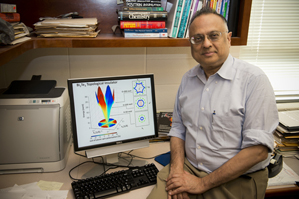What is a topological insulator?

 What is a topological insulator? This is what I have written at the top of my notes from a conversation a couple weeks ago with theoretical condensed matter physics professor Arun Bansil, who has just published two new articles about topological insulators in Nature Magazine. But it took about three pages of frantically scribbled notes before the answer finally began to surface.
What is a topological insulator? This is what I have written at the top of my notes from a conversation a couple weeks ago with theoretical condensed matter physics professor Arun Bansil, who has just published two new articles about topological insulators in Nature Magazine. But it took about three pages of frantically scribbled notes before the answer finally began to surface.
I will spare you the wind up of our conversation, which mostly had to do with the fact that I haven’t taken a physics class in over a decade, and get right to it:
A topological insulator is a material whose surface is conductive but whose inside is not. While that may sound pretty straightforward, guess again. There’s no obvious reason why a material of uniform structure should display such different properties in different parts. “It’s all about topology and one of the most basic symmetries of nature—the time reversal symmetry,” said Bansil.
These two key concepts – topology and time reversal symmetry – were totally new to me. In fact, I had no idea there were even multiple kinds of symmetries at all. I’m familiar with mirror symmetry, as you probably are, too. But time reversal symmetry is a bit more mind-blowing. It refers to the basic property of physical laws which guarantees that a ball going up follows the same laws as a ball going down. If you record a video of a ball going up and down continuously, you can’t tell if the movie is in play mode or rewind.
Topology at first seems completely unrelated to symmetry, but apparently it is intimately connected. Basically, topology describes the unique properties of an object’s surface and follows the rule that certain types of topologies cannot be exchanged with others. Compare, for example, a soccer ball with a doughnut. Without punching a hole in the ball, there’s no way to turn it into a doughnut. There is something fundamentally different about the nature of these two objects. But with a bit of imagination, you can see how a handled cup might fluidly turn into a doughnut.
In topological insulators, the interface between the conductive surface and the non-conducting bulk material behaves as if a soccer ball were spontaneously transforming into a doughnut, so to speak, and this gives birth to the new types of conductive states on the surface.
In a regular old insulator (or most materials for that matter), electrons are bopping back and forth between one “spin” direction and another. But in a topological insulator, time reversal symmetry protects the spin of each state and the electrons cannot hop between different spins.
Bansil’s team’s first Nature article explores the fact that magnetic impurities in the material will break the time reversal symmetry and cause spins to flip. Strategically placed impurities could turn topological insulators into very resilient on-off switches. In quantum computing, these materials could one day replace the zeros and ones of traditional computers.
Another application for these weird babies is spintronics, an emerging technology that exploits electron spins in electronic devices rather than the charge of the electron, which is the case in much of the current electronic technology. In normal materials, the number of up and down spins is roughly equal. In topological insulators there is a natural tendency for the spins to be separated and to be protected from flipping by the time reversal symmetry, allowing the possibility of novel spintronics applications.
The second Nature article explores how in some materials conducting states on the surface could be protected via mirror symmetry of the system rather than time reversal symmetry, and thus lead to yet another new kind of insulator in which the surface states could be more easily manipulated for various applications. Bansil’s team predicts tin telluride to be one such new type of insulator.
For more articles about Bansil’s work with topological insulators, see Science, Nature Physics, and Physical Review Letters.





